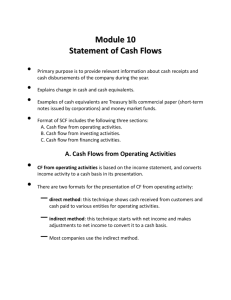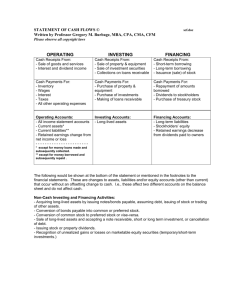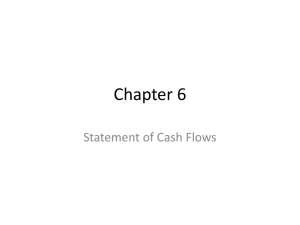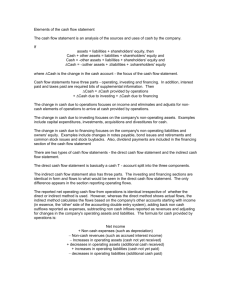statement of cash flows
advertisement
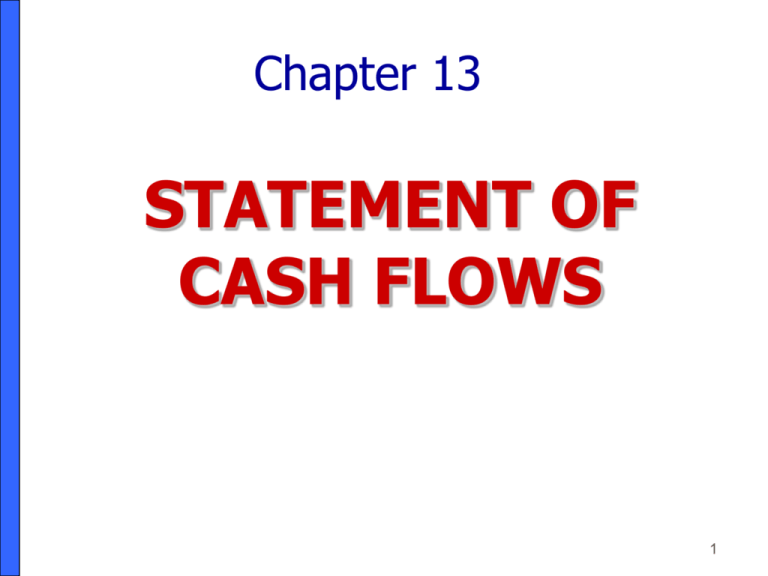
Chapter 13 STATEMENT OF CASH FLOWS 1 Questions the Statement of Cash Flow Answers 2 The Primary Purpose of the Statement of Cash Flows Is... • To provide information about: – cash receipts, – cash payments, and – the net change in cash resulting from: •operating, •investing, and •financing activities of a company during a period. Why Report the Causes of Changes in Cash? Because investors, creditors, and other interested parties want to know what is happening to a company’s most liquid asset, CASH 4 Usefulness of the Statement of Cash Flow • The entity’s ability to generate future cash flows. • The entity’s ability to pay dividends and meet obligations. • The reason for the difference between net income and net cash provided (used) by operating activities. • The cash investing and financing transactions during the period. 5 Operating Activities... Include: – The cash effects of transactions that create revenues and expenses and – Enter into determination of net income. Involve Income Statement Items 6 Operating Activities… Types of Cash Flows • Cash inflows: – From sale of goods or services – From return on loans (interest received) and on equity securities (dividends received) • Cash outflows: – To suppliers for inventory – To employees for services – To government for taxes – To lenders for interest – To others for expenses 7 Investing Activities... Include: – Purchasing and disposing of investments and productive long-lived assets using cash and – Lending money and collecting the loans. Involve Investments and Noncurrrent Asset Items 8 Investing Activities... Types of Cash Flows • Cash inflows: – From sale of property, plant, and equipment – From sale of debt or equity securities of other entities – From collection of principal on loans to other entities • Cash outflows: – To purchase property, plant, and equipment – To purchase debt or equity securities of other entities – To make loans to other entities 9 Financing Activities... Include: – Obtaining cash from issuing debt and repaying the amounts borrowed and – Obtaining cash from stockholders and paying dividends. Involve Noncurrent Liability and Stockholders’ Equity Items 10 Financing Activities... Types of Cash Flows • Cash inflows: – From sale of equity securities (company's own stock) – From issuance of debt (bonds and notes) • Cash outflows: – To stockholders as dividends – To redeem long-term debt or reacquire capital stock 11 Operating Activities - ALERT Some cash flows relating to investing or financing activities are classified as operating activities. For example... • Receipts of investment revenue (interest and dividends) and • Payments of interest to lenders are classified as operating activities because these items are reported in the income statement. Significant Noncash Activities... • That do NOT affect cash are NOT reported in the body of the statement of cash flows. • Are reported: – In a separate schedule at the bottom of the statement of cash flows or – In a separate note or supplementary schedule to the financial statements. Significant Noncash Activities... 1. Issuance of common stock to purchase assets. 2. Conversion of bonds into common stock. 3. Issuance of debt to purchase assets. 4. Exchanges of plant assets. 14 Question Which is an example of a cash flow from an operating activity? a. Payment of cash to lenders for interest. b. Receipt of cash from the sale of capital stock. c. Payment of cash dividends to the company’s stockholders. d. None of the above. Question Which is an example of a cash flow from an operating activity? a. Payment of cash to lenders for interest. b. Receipt of cash from the sale of capital stock. c. Payment of cash dividends to the company’s stockholders. d. None of the above. Format Three parts: – Operating – Investing – Financing Body of Statement Plus significant noncash investing and financing activities in separate schedule or at bottom of the. Major Steps in Preparing Statement of Cash Flows Major Steps in Preparing Statement of Cash Flows In order to perform step 1 a company MUST convert net income from a cash to accrual basis. Can used the Direct Method or Indirect Method Over Ninety-eight (98.8)% of companies use the indirect method. Indirect Method • The indirect method is used extensively in practice. • Most companies favor the indirect method for the following reasons: – it is easier to prepare. – it focuses on the differences between net income and net cash flow from operating activities. – it tends to reveal less company information to competitors. Statement Of Cash Flows Indirect Method • Start with Net Income Determine Net Cash Provided/Used By Operating Activities • Adjust net income for items that did not affect cash. • Net income must be converted because – Noncash expenses, such as depreciation must be added back. – Earned revenues may include credit sales that have not been collected in cash. – Expenses incurred that may not have been paid. Constructing the Statement of Cash Flows Using Noncash Balance Sheet Accounts Increases in noncash asset accounts imply uses of cash. Example: Inventory is purchased on credit from a supplier. It is implied that cash was used to acquire the inventory. Constructing the Statement of Cash Flows Using Noncash Balance Sheet Accounts Decreases in noncash assets accounts imply sources of cash. Example: Accounts receivable decreases when a customer pays their bill. When the customer pays his bill, the company’s cash increases. Constructing the Statement of Cash Flows Using Noncash Balance Sheet Accounts Increases in liability accounts imply sources of cash. Example: Inventory is purchased on credit from a supplier. It is implied that an increase in a payable has the effect of increasing cash available for other uses. Constructing the Statement of Cash Flows Using Noncash Balance Sheet Accounts Decreases in liability accounts imply uses of cash. Example: The company made a payment on a note payable held by a creditor. When the company makes the payment, cash decreases. I.O.U. Question Which of the following would be considered a "use" of cash for purposes of constructing a statement of cash flows? a. an increase in accounts payable. b. an increase in prepaid expenses. c. an increase in accrued liabilities. d. an increase in accumulated depreciation. Question Which of the following would be considered a "use" of cash for purposes of constructing a statement of cash flows? a. an increase in accounts payable. b. an increase in prepaid expenses. c. an increase in accrued liabilities. d. an increase in accumulated depreciation. Operating Activities Net Income (Loss) $ XXX Add: XXX XXX XXX XXX (XXX) (XXX) (XXX) $ XXX Decr. in Current Noncash Assets Incr. in Current Liabilities Depreciation Charges Losses Less: Incr. in Current Noncash Assets Decr. in Current Liabilities Gains Net Cash Flows from Operating Activities Includes those activities that enter into the determination of net income Investing Activities Add: Proceeds from sale of land, buildings, equipment, or other noncurrent assets Receipt of principal from investments Less: Payments to acquire land, buildings, equipment, or other noncurrent assets Payments to acquire investments Net Cash Flows from Investment Activities $ XXX XXX (XXX) (XXX) $ XXX Includes transactions that involve the acquisition or disposal of noncurrent assets. Financing Activities Add: Proceeds from borrowings Proceeds from issuing capital stock Proceeds from sale of bonds Less: Principal payments on borrowed funds Payments related to bond maturities Dividend payments Net Cash Flows from Investment Activities $ XXX XXX XXX (XXX) (XXX) (XXX) $ XXX Includes transactions involving receipts from or payments to creditors and owners. Question Which is an example of a cash flow from a financing activity? a. Receipt of cash from sale of land. b. Issuance of debt for cash. c. Purchase of equipment for cash. d. None of the above. Question Which is an example of a cash flow from a financing activity? a. Receipt of cash from sale of land. b. Issuance of debt for cash. c. Purchase of equipment for cash. d. None of the above. Question An increase in the Interest Payable account of a company from $0 at the beginning of the year, to $1,000 at the end of the year, would be shown on the company's statement of cash flows prepared under the indirect method as: a. a source of cash of $1,000 in Operating Activities. b. a use of cash of $1,000 in Operating Activities. c. a source of cash of $1,000 in Investing Activities. d. a use of cash of $1,000 in Financing Activities. Question An increase in the Interest Payable account of a company from $0 at the beginning of the year, to $1,000 at the end of the year, would be shown on the company's statement of cash flows prepared under the indirect method as: a. a source of cash of $1,000 in Operating Activities. b. a use of cash of $1,000 in Operating Activities. c. a source of cash of $1,000 in Investing Activities. d. a use of cash of $1,000 in Financing Activities. Indirect and Direct Methods • Both methods arrive at the same total amount for “Net cash provided by Operating Activities”. • The methods differ in disclosing the items that make up the total amount. • The choice of methods affects only the operating activities section; the investing and financing activities sections are the same. Direct Method • The FASB prefers the direct method but allows the use of either method. • When the direct method is used, the net cash flow from operating activities as computed using the indirect method must also be reported in a separate schedule. Technology Services Company Statement of Cash Flows--Direct Method (Partial) For the Year Ended December 31, 2008 Cash flows from operating activities Cash receipts from customers $ 765,000 Cash payments To supplier $550,000 For operating expenses 158,000 For income taxes 48,000 756,000 Net cash provided by operating activities $ 9,000 Formula to Compute Cash Receipts from Customers-Direct Method Formula to Compute Cash Payment to Suppliers - Direct Method Formula to Compute Cash Payments for Operating Expenses-Direct Method Direct Method or Indirect Method? Indirect Method Direct Method • Net income is reconciled to cash flow from operating activities. • Net income is reconstructed on a cash basis. • No supplemental schedule is required. • Requires a supplemental reconciliation of net income to cash flow from operating activities. • Used by 98.8% of companies. • Used by 1.2% of companies. Product Life Cycle • A series of phases all products go through • The phases are often referred to as the: – introductory phase – growth phase – maturity phase – decline phase • The phase a company is in affects its cash flows. Introductory Phase To support asset purchases the company may issue stock or debt. Expect: • cash from operations to be negative. • cash from investing to to be negative. • cash from financing to be positive. Growth Phase The company is striving to expand its production and sales. Expect: • small amounts of cash to be generated from operations. • cash from investing to be negative. • cash from financing to be positive. Maturity Phase Sales and production level-off. Expect: • cash from operations to exceed investing needs. • cash from investing to be neutral. • cash from financing to be negative. Decline Phase Sales and production decline. Expect: • cash from operations to decline. • cash from investing to possibly become positive. • cash from financing to possibly become negative. 47 Impact of Product Life Cycle on Cash Flows 48 Free Cash Flow • In the Statement of Cash Flows, cash from operations is intended to indicate the cashgenerating capability of the company. • Statement of Cash flows fails to take into account that a company must invest in new fixed assets to maintain its current level of operations and it must maintain dividends at current levels to satisfy investors. Free Cash Flow Cash Provided By Operations – Capital Expenditures – Dividends Paid Free Cash Flow Using Cash Flows to Evaluate a Company The 2008 statement of cash flows of Microsoft Corporation provides information for the computations of these measures. MICROSOFT CORPORATION STATEMENT OF CASH FLOWS (PARTIAL) 2008 Cash flows from operations Additions to property, plant, and equipment Acquisition of companies Sales of investments, net of purch. Cash used by investing activities $21,612 $ (3,182) (8,053) 6,648 (4,587) MICROSOFT CORPORATION STATEMENT OF CASH FLOWS (Partial) 2008 Cash flows from operations Less: Expenditures on property, plant, and equipment Dividends Free Cash Flow 21,612 3,182 4,015 14,415 Assessing Liquidity, Solvency, and Profitability Using Cash Flows In addition to using numbers from the income statement for assessment purposes, we often use numbers from the statement of cash flows. The ratios are cash-based instead of accural-based. 53 Cash-Based Measures • Accrual-based measures allow too much management discretion. • One disadvantage to the cash-based measures is no readily available published industry averages for comparison are available. Liquidity • Liquidity is the ability of a business to meet its immediate obligations. • One measure of liquidity is the current ratio. – A disadvantage of the current ratio is that it uses year-end balances of current assets and current liabilities. (May not be representative of a company's position during most of the year.) – Also, it is subject to some “window dressing” such as paying down payables prior to Y/E. Current Cash Debt Coverage Ratio • A ratio that partially corrects this is the current cash debt coverage ratio. Cash provided by operations Average current liabilities • Since cash from operations involves the entire year rather than a balance at one point in time, it is often considered a better representation of liquidity on the average day. Solvency • Solvency is the ability of a firm to survive over the long term. – One measure of solvency is the debt to total assets ratio. • A measure of solvency that uses cash figures is the cash debt coverage ratio. Cash Provided By Operations Average Total Liabilities • This ratio measures a company's ability to repay its liabilities from cash generated from operations. Current Cash Debt Coverage Ratio Current Cash Debt Coverage Ratio Cash Provided by Operations = . Average Current Liabilities Cash Debt Coverage Ratio Cash Debt Coverage Ratio = Cash Provided by Operations . Average Total Liabilities Profitability • Profitability refers to a company's ability to generate a reasonable return. • Accrual-based ratios that measure profitability are the gross profit rate, profit rate margin, and return on assets. • A cash-based measure of performance is the cash return on sales ratio. Question The data given below are from the accounting records of the Kuhn Company: Net Income (accrual basis) ....................... $45,000 Depreciation Expense ............................... $ 9,000 Decrease in Accounts Payable .................. $ 2,500 Decrease in Merchandise Inventory ........ $ 3,000 Increase in Long-term Liabilities ............ $10,000 Sale of Capital Stock for cash .................. $30,000 Increase in Accounts Receivable .............. $ 4,500 Based on this information, the cash provided by operating activities using the indirect method would be: a. b. c. d. $55,000. $50,000. $58,000. $60,000. End of Chapter 13 Now, this is what I call CA$H FLOW!


